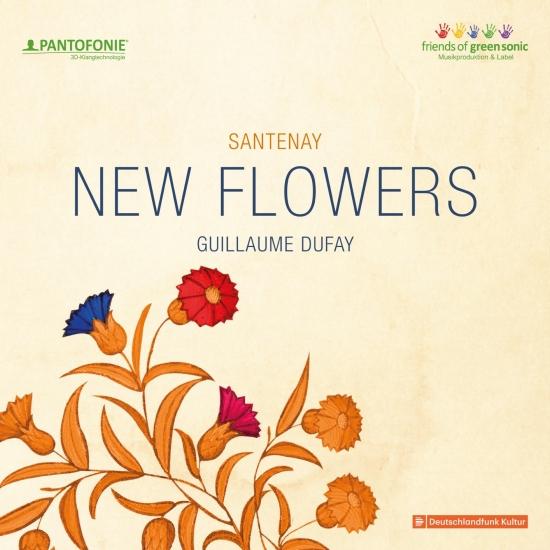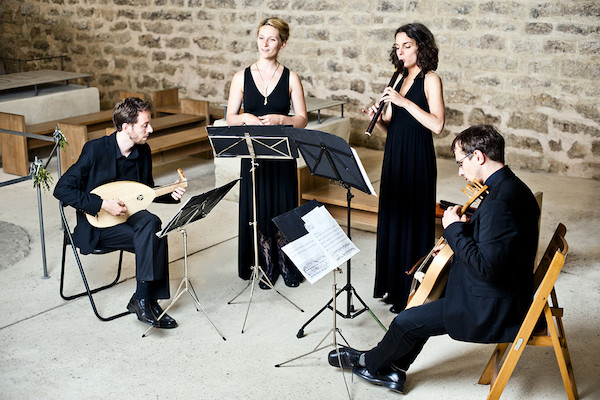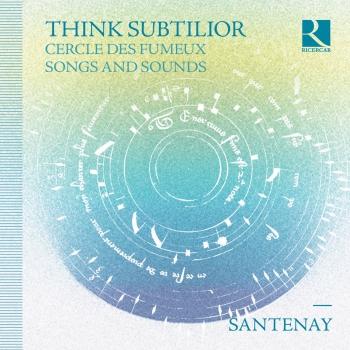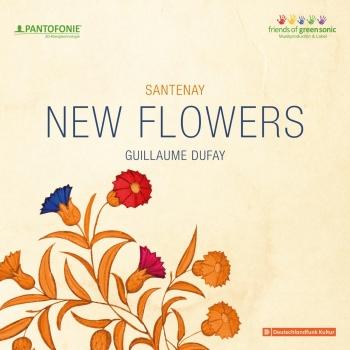
NEW FLOWERS Santenay
Album info
Album-Release:
2018
HRA-Release:
14.05.2018
Label: friends of green sonic
Genre: Classical
Subgenre: Vocal
Artist: Santenay
Composer: Guillaume Dufay (1397-1474)
Album including Album cover Booklet (PDF)
- Guillaume Dufay (1397-1474):
- 1Belle, que vous ay ie mesfait02:51
- 2L'alta belleza tua, virtute, valore02:06
- 3Par droit je puis bien complaindre et gemir04:26
- 4Se la face ay pale03:05
- 5He, compaignons, resvelons nous04:39
- 6Par le regard de vos beaux yeux03:48
- 7Qui latuit in virgine01:51
- 8Donnés l'assault a la fortresse04:52
- 9Les douleurs, dont me sens tel somme03:58
- 10Resistera02:28
- 11Vergene bella03:45
- 12Parleregart etc. Ad huc semel01:36
- 13Resvellies vous et faites chiere lye05:59
- 14Je languis en piteux martire07:05
- 15Ave virgo que de celis03:05
- 16Ce moys de may03:21
Info for NEW FLOWERS
NEW FLOWERS – for the ear and the soul.
The timeless music of Renaissance composer Guillaume Dufay blossoms with new sound for the modern, 21st Century audience – in the highest resolution worldwide for the first time.
A new flower: The new beauty of timeless music.
Early music for a new time: The album ‘NEW FLOWERS’ transports the works of Renaissance com-poser Guillaume Dufay (from 1400 - 1474) into the here and now of our modern, 21st century world. This music is more interesting and current than ever before, especially today: The beauty and con-templative aura of the compositions provide the listener with joy, peace and inner harmony. The music of Guillaume Dufay speaks to people directly. The melodies, harmonies and feelings serve to soothe us – and go straight to the heart. The ‘NEW FLOWERS’ album lets the diverse repertoire of this mas-ter of inwardness be rediscovered.
The album is designed for listeners far beyond the traditional audience of early music fans. The re-cording technology and the new possibilities which have been achieved as a result are also of interest for lovers of technology: For the first time, digitally-recorded music sounds as warm and as nuanced as only achieved by vinyl albums up until now – a revolution worth listening to!
A new flower: The new style of a brilliant ensemble.
SANTENAY – four musicians from four nations: Julla von Landsberg (Germany), Elodie Wiemer (France), Szilárd Chereji (Romania) and Orí Harmelin (Israel) are brought together through their mu-tual interest in medieval music. The ensemble is a discovery: The four young musicians tackle the works with new ease and refreshing drive. They interpret the instrumental and vocal music of this early composer in today’s sense in all its timelessness for a modern audience. The ensemble gives the clear melodies an elegance, transparency and emotional depth which affects and moves the listener.
SANTENAY performs the 14th and 15th century works on those instruments which were common at the time. As no recommendations for the line-up emerged from the old manuscripts, they allocate the most suitable instrument to each voice. In this way, an enchanting and mesmerising form of music is formed – one which is both traditional and timelessly modern.
A new flower: The new experience of a 3D sound.
The album ‘NEW FLOWERS’ also bears this title because it reaches a new dimension in sound. Ever since the market introduction of the CD at the beginning of the 1980’s, digital recordings still fail to come close to analogue sound quality, despite having diverse technologies at their disposal. This is why friends of green sonic are taking a different approach to audio recording: The label makes use of the high time signal, and thus sound, resolution of MHz.PCM. The music is recorded with 24-bit PCM and a sampling rate of 4.2336 MHz in a specially-developed, prize-winning audio recorder named ‘clàr’. The completely new recording quality which arises as a result offers the listener a warm yet, at the same time, very precise sound – the first performance can be heard on this album.
What’s more, the album, recorded in the legendary sendesaal bremen [Bremen Broadcasting Hall] with high end artificial head technology, enables Dufay’s music to be heard in 3D audio – in as much fascinating detail as if the listener was actually sitting in the concert hall.
Lavish album booklet – Introduction to the Renaissance
A creatively elaborate 84-page album booklet provides an extensive introduction to the composer, the works, the ensemble, the recording technology and much more, in both German and English. The text also introduces the times and the music of the Renaissance in an easy-to-understand manner. Well-known musicologist and Guillaume Dufay expert Prof. Dr. Laurenz Lütteken from the Institute for Mu-sicology at the University of Zurich could be recruited as the author of the text. In this way, the listener receives an even greater understanding for the thrilling compositions and the world of emotions during this age of enlightenment.
The album is available in multiple formats up to 352.8 kHz, 24 bit – at this level, you can experience the music of Guillaume Dufay in particular intensity and high quality through the technical innovation of the highest sound resolution in the world.
‘NEW FLOWERS’ sets new standards as regards the interpretation and sound of early music –
new flowers for the ear and the soul.
A co-production with Deutschlandfunk Kultur
Julla von Landsberg, Voice, Organetto
Elodie Wiemer, Recorder
Szilárd Chereji, Vielle
Orí Harmelin, Lute

Ensemble Santenay
The fascination with music of the middle ages led to the creation of Ensemble Santenay in 2004. Initial independent exploration of the repertoire led to several years of collaboration with medievalist pioneer Kees Boeke as a part of a study at the academy of music in Trossingen, Germany.In 2008 the ensemble relieces it’s Debut CD Santenay- LIVE. Numerous Performances led these four friends from, Israel, France, Germany and Transylvania throughout Europe. The origin of the Ensemble’s name is a town in the former duchy of Burgundy.
Santenay sets Medieval and Early Renaissance music on instruments typical for the period, that is, on the recorder, the vielle, the lute and the organetto. In the original manuscripts there are no indications of instrumentation; therefore it is open to the musicians to decide on the most suitable instrument for each part. In addition to countless monodies, many three-part (and some two- and four-part) works were composed by fourteenth and fifteenth centuries court musicians.
The core of each piece is the tenor line (from latin: "tenere" meaning "to hold"). Santenay usually sets the tenor voice with the vielle, which, as a string instrument, is best suited for the long notes of the textless melody.
In perfect counterpoint to the tenor is the cantus line (from latin: "cantare" meaning "to sing"). When a text is present, Santenay sets this line with voice and an additional instrument such as the recorder or the organetto, which supports the singer and can take over the cantus in instrumental interludes.
The contrasting voice to the tenor is the countertenor, which offers divergent rhythms and harmonic elements with an improvisatory character. Santenay generally sets this part with the lute.












